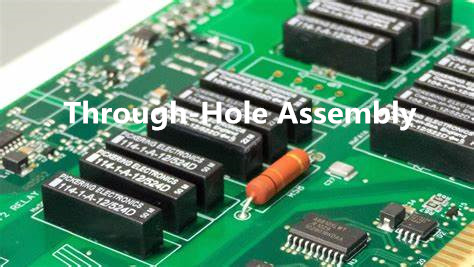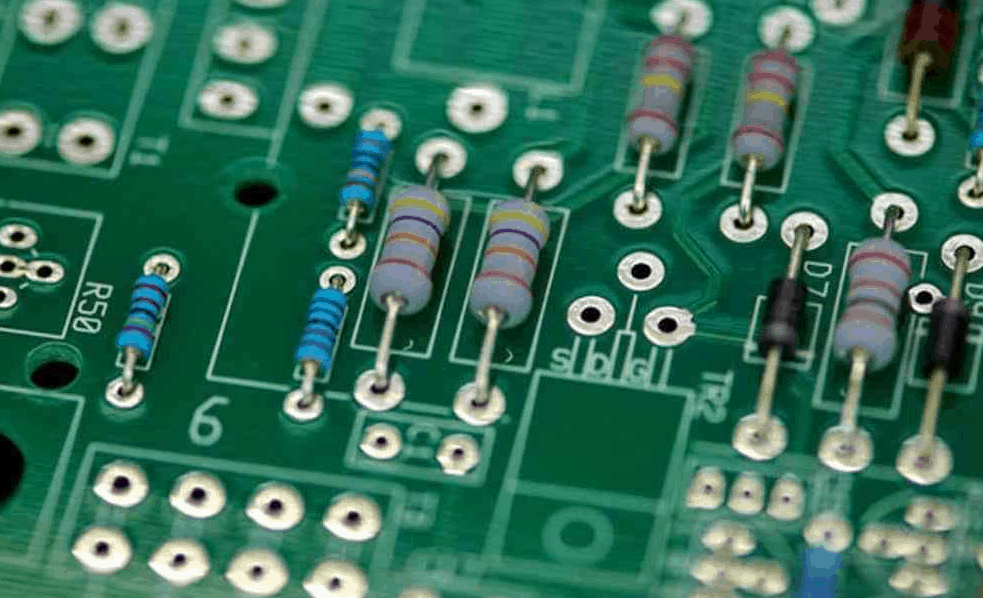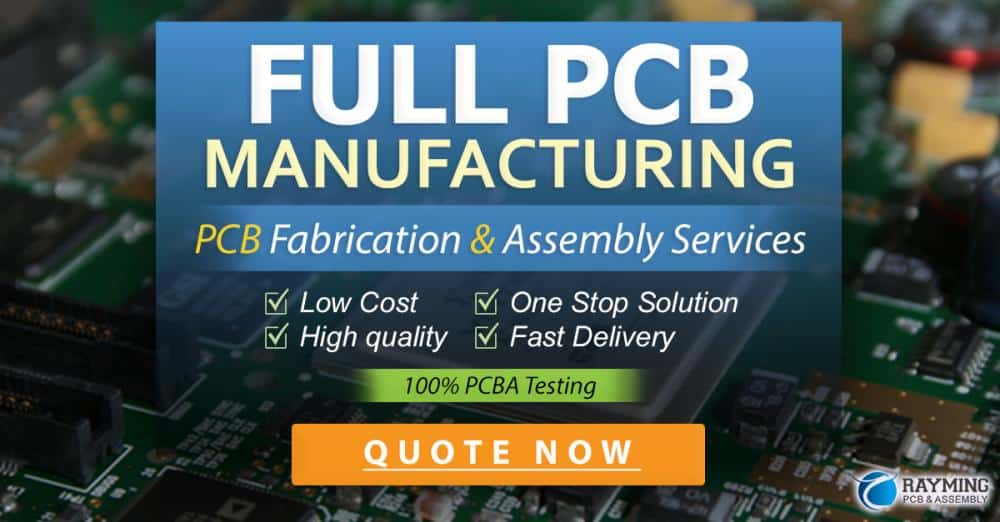Custom through hole PCBs are a popular choice for electronic devices that require a high level of durability and reliability. These PCBs are designed with holes drilled through the board, allowing for components to be inserted and soldered in place. This method of assembly is preferred for applications that require a strong mechanical connection between the board and components.
One of the main advantages of custom through hole PCBs is their ability to withstand high levels of stress and strain. The components are securely anchored to the board, making them less likely to detach or break loose during use. Additionally, through hole PCBs offer better resistance to vibration, shock, and temperature changes, making them ideal for use in harsh environments.
Custom through hole PCBs also offer a high level of flexibility in terms of design and customization. The holes can be placed in a variety of configurations, allowing for greater control over the layout of the board and the placement of components. This makes it easier to optimize the board for specific applications, ensuring that it meets the precise requirements of the project.
What is a Custom Through Hole PCB?
A custom through hole PCB refers to a printed circuit board (PCB) that is designed to accommodate through hole components. Through hole components are electronic components that have leads that are inserted into holes on the PCB and then soldered in place.
Custom through hole PCBs are typically designed to meet specific requirements, such as size, shape, and functionality. They are often used in applications where surface mount technology (SMT) components are not suitable, such as in high-temperature or high-vibration environments.
Custom through hole PCBs can be designed and manufactured to meet a wide range of specifications, including:
- Number and size of holes
- Placement of components
- Trace widths and spacing
- Number of layers
- Material type and thickness
Custom through hole PCBs can be used in a variety of applications, including industrial controls, power supplies, and audio equipment. They are often preferred over SMT components in applications where high power or high voltage is involved, as they offer better heat dissipation and can handle higher currents.
In summary, a custom through hole PCB is a type of PCB that is designed to accommodate through hole components and can be customized to meet specific requirements. They are often used in applications where SMT components are not suitable and offer advantages in high-power or high-voltage applications.
Benefits of Custom Through Hole PCBs
Increased Durability
Custom through hole PCBs offer increased durability compared to surface mount technology (SMT) PCBs. Through hole components are mechanically secured to the board, providing a stronger connection that is less likely to fail due to vibration or other external factors. This makes custom through hole PCBs a great choice for applications that require high reliability and long-term performance.
Improved Performance
Through hole components also offer improved performance in certain applications. For example, through hole resistors and capacitors can handle higher power levels than their SMT counterparts, making them ideal for high-power applications. Additionally, through hole components can be easier to replace or modify, which can be important for prototyping or development purposes.

Cost Savings
Custom through hole PCBs can also offer cost savings compared to SMT PCBs. Through hole components are typically less expensive than SMT components, which can help reduce overall material costs. Additionally, through hole components can be easier to work with during assembly, which can help reduce labor costs and improve overall efficiency.
In summary, custom through hole PCBs offer increased durability, improved performance, and cost savings compared to SMT PCBs. These benefits make custom through hole PCBs an attractive option for a wide range of applications.
Design Considerations for Custom Through Hole PCBs
When designing a custom through hole PCB, there are several design considerations that must be taken into account. These include component placement, trace routing, and drill hole placement.
Component Placement
The placement of components on a PCB can greatly affect the overall performance and functionality of the circuit. When designing a custom through hole PCB, it is important to consider the placement of components to ensure that they are located in the optimal position for their intended function.
Some key factors to consider when placing components include:
- Signal integrity: Components that handle high-frequency signals should be placed close together to minimize signal loss and interference.
- Thermal management: Components that generate heat should be placed in areas with good airflow to prevent overheating.
- Accessibility: Components that may need to be replaced or serviced should be placed in easily accessible locations.
Trace Routing
Trace routing is the process of connecting components on a PCB using conductive traces. When designing a custom through hole PCB, it is important to consider the routing of these traces to ensure that they are optimized for performance and reliability.
Some key factors to consider when routing traces include:
- Signal integrity: Traces that carry high-frequency signals should be routed away from sources of interference and should be kept as short as possible.
- Thermal management: Traces that carry high currents should be routed with sufficient width to prevent overheating.
- Space constraints: Traces should be routed in a way that minimizes the amount of board space required.
Drill Hole Placement
Drill holes are used to connect components on different layers of a PCB. When designing a custom through hole PCB, it is important to consider the placement of these drill holes to ensure that they are optimized for performance and reliability.
Some key factors to consider when placing drill holes include:
- Signal integrity: Drill holes should be placed in a way that minimizes the amount of signal loss and interference.
- Thermal management: Drill holes should be placed in a way that allows for sufficient airflow to prevent overheating.
- Space constraints: Drill holes should be placed in a way that minimizes the amount of board space required.
Overall, designing a custom through hole PCB requires careful consideration of a variety of factors. By taking into account these design considerations, it is possible to create a PCB that is optimized for performance and reliability.
Manufacturing Process for Custom Through Hole PCBs
Design Review and Approval
Before beginning the manufacturing process for custom through hole PCBs, a design review and approval process is necessary. The design review ensures that the PCB design meets all the necessary requirements and specifications. This includes checking for any errors or issues that may arise during the manufacturing process. Once the design is approved, it is sent to the manufacturing team.
Material Selection
The next step in the manufacturing process is material selection. The materials used in the PCB must meet the specific requirements of the design. This includes selecting the right type of substrate, copper foil, and solder mask. The thickness of the materials used will also depend on the design requirements.
Drilling and Plating
After material selection, the PCB is drilled and plated. Drilling involves creating holes in the PCB where the through-hole components will be inserted. Plating is the process of depositing a thin layer of metal onto the surface of the PCB. This helps to create the necessary connections between the different components on the board.
Assembly and Testing
The final step in the manufacturing process is assembly and testing. The through-hole components are inserted into the drilled holes and soldered into place. Once the assembly is complete, the PCB is tested to ensure that it meets all the necessary requirements. This includes checking for any defects or issues that may have arisen during the manufacturing process.

In conclusion, the manufacturing process for custom through hole PCBs involves several steps, including design review and approval, material selection, drilling and plating, and assembly and testing. By following these steps, manufacturers can ensure that the final product meets all the necessary requirements and specifications.
Applications of Custom Through Hole PCBs
Custom through hole PCBs have a wide range of applications across various industries. Some of the most common applications of custom through hole PCBs are:
Industrial Automation
Custom through hole PCBs are widely used in industrial automation for controlling and monitoring the manufacturing processes. These PCBs are designed to withstand harsh industrial environments and can operate in extreme temperatures. They are used in various industrial automation applications, including:
- Motor control
- Robotics
- Process control
- Data acquisition
Medical Devices
Custom through hole PCBs are also used in the medical industry for various applications, including:
- Medical imaging equipment
- Diagnostic equipment
- Patient monitoring systems
- Implantable devices
These PCBs are designed to meet strict medical standards and regulations and are manufactured using high-quality materials to ensure reliability and safety.
Military and Aerospace
Custom through hole PCBs are widely used in military and aerospace applications due to their high reliability and durability. These PCBs are designed to withstand extreme temperatures, shock, and vibration and are used in various military and aerospace applications, including:
- Navigation systems
- Communication systems
- Radar systems
- Missile guidance systems
Custom through hole PCBs are also used in various other applications, including automotive, consumer electronics, and telecommunications.
In conclusion, custom through hole PCBs have a wide range of applications across various industries due to their reliability, durability, and high-quality design.
Choosing a Custom Through Hole PCB Manufacturer

When it comes to custom through hole PCBs, choosing the right manufacturer is crucial to ensure the quality, reliability, and functionality of your product. Here are some factors to consider when selecting a manufacturer:
Experience and Expertise
Look for a manufacturer with a proven track record of experience and expertise in producing custom through hole PCBs. Check their portfolio and customer reviews to see if they have worked on similar projects to yours. A manufacturer with extensive experience and expertise can provide valuable insights and recommendations to optimize your design and ensure its manufacturability.
Quality Control Measures
Quality control is critical in the manufacturing process of custom through hole PCBs. A reputable manufacturer should have a comprehensive quality control system in place to ensure that each board meets the required specifications and standards. This includes testing and inspection procedures throughout the production process to identify and correct any defects or issues.
Customer Support
Good customer support is essential in any business relationship, and PCB manufacturing is no exception. A manufacturer with excellent customer support can provide timely and effective communication, answer any questions or concerns, and provide updates on the progress of your project. Look for a manufacturer with a dedicated customer support team that is easy to reach and responsive to your needs.
In conclusion, choosing the right custom through hole PCB manufacturer is crucial to ensure the success of your project. Consider the manufacturer’s experience and expertise, quality control measures, and customer support when making your decision.
Comments are closed